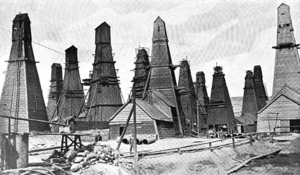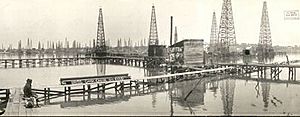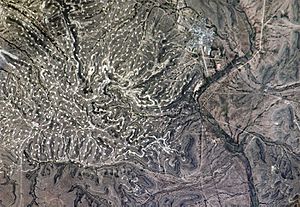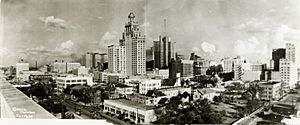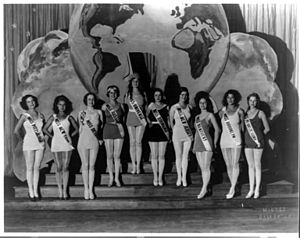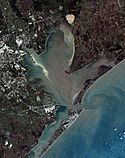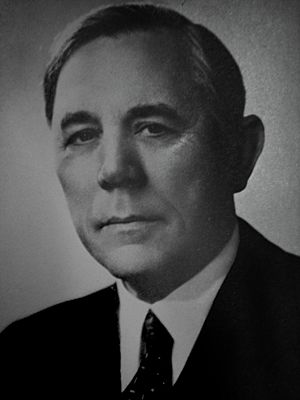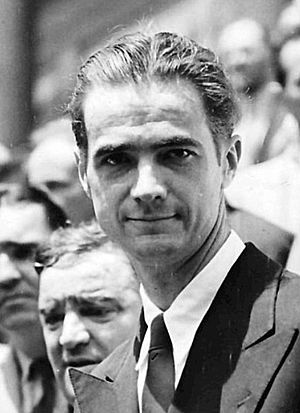Texas oil boom facts for kids
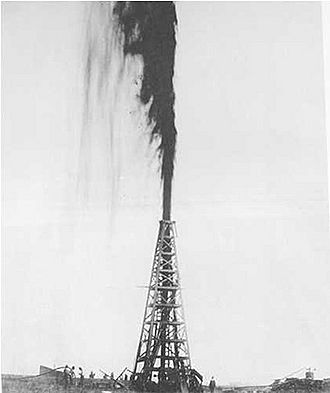
The Lucas gusher at Spindletop, the first major gusher in Texas
|
|
| Date | 1901 – 1940s |
|---|---|
| Location | Texas, United States |
| Also known as | Gusher Age |
The Texas oil boom, also known as the gusher age, was a time of huge change and growth in Texas. It happened in the early 1900s. This period started when a massive amount of oil was found near Beaumont, Texas.
This oil discovery was the biggest in the world at the time. It led to super fast growth and new industries across Texas. Texas quickly became a top oil-producing state. Soon, the United States produced more oil than the Russian Empire. By 1940, Texas was making most of the oil in the U.S. Some historians even say this era in Texas started the world's "Oil Age."
The first big oil finds happened in Southeast Texas. But soon, oil was found all over the state. Wells were built in North Texas, East Texas, and West Texas. Small amounts of oil were found in the 1800s. However, the discovery at Spindletop in 1901 got everyone's attention. This led to lots of oil exploration and development.
This time period completely changed Texas. At the start of the 1900s, Texas was mostly farms and small towns. By the end of World War II, it had many factories and big cities. Texas cities grew to be among the largest in the U.S. Houston benefited the most from the boom. The Houston area became home to the most oil refineries and chemical plants in the world. Houston grew from a small town in 1900 to one of the biggest cities in the U.S. The boom also helped other Texas cities grow. This included the Beaumont and Port Arthur area where the boom began.
Four important businessmen during this time were H. Roy Cullen, H. L. Hunt, Sid W. Richardson, and Clint Murchison. They became some of the richest and most powerful people in Texas and the country.
Contents
When the Texas Oil Boom Happened
Some people think oil growth in Texas started in the 1800s. For example, the Corsicana oil field opened in 1894. But most historians agree that the Spindletop discovery in 1901 was the real start. This well was the most productive oil well ever found at that time. This single discovery brought fast changes to Texas. It also brought worldwide attention to the state.
By the 1940s, the Texas Railroad Commission started to control the oil industry. They helped make oil production steady. This stopped the wild price changes common in earlier years. Many small towns, like Wortham, became "boomtowns" in the 1920s. But their booms ended in the late 1920s and early 1930s. Their economies crashed because they depended on small oil fields. When oil production slowed and the Great Depression lowered demand, investors left.
In bigger cities like Beaumont, Houston, and Dallas, the boom continued until World War II ended. By then, the economies of these major cities had grown strong. Texas kept growing and doing well. However, the extreme growth and big social changes of the early years slowed down. Cities started to grow at a more steady pace. Still, some smaller communities in West Texas kept having local oil booms after the war.
Texas Before the Oil Boom
After the American Civil War, Texas's economy grew quickly. It focused on cattle ranching, cotton farming, and lumber. Galveston became the world's top cotton shipping port. It was also Texas's biggest business center. But by 1890, Dallas had more people than Galveston. In the early 1900s, the Port of Houston started to challenge Galveston's lead.
In 1900, a huge hurricane hit Galveston. It destroyed much of the city. Another storm in 1915 also caused damage. These events made investors focus on nearby Houston. Houston was seen as a safer place for businesses. Because of this, the coming oil boom became very focused on Houston. Houston became important as both a port and a business center.
Even though Texas had some notable cities, it was still mostly a rural state. Much of Texas was "open range." This meant that livestock could roam freely everywhere.
Early Oil Discoveries
In the 1850s, Abraham Gesner invented a way to make kerosene from oil. The demand for oil as a fuel for lights grew fast around the world. Oil exploration started in many places. The Russian Empire, especially the Branobel company in Azerbaijan, led the world in oil production by the late 1800s.
In 1859, Edwin Drake in Pennsylvania invented a way to drill for oil deep underground. Drake's invention helped start the oil industry in the U.S.. The first oil refinery in the U.S. opened in 1861 in Pennsylvania. Standard Oil, started by John D. Rockefeller, grew to control much of the early U.S. oil industry.
Texans knew about the oil underground for decades. But they often saw it as a problem. It made it hard to dig for water wells. Rancher William Thomas Waggoner found oil while drilling for water in 1902. He later became a rich oil businessman. He said, "I wanted water, and they got me oil. I tell you I was mad, mad clean through."
Even with these early negative feelings about oil, the demand for kerosene grew. This led to more oil searching in Texas after the Civil War. People looked near oil-producing springs and where oil was accidentally found while drilling for water. One of the first important wells in Texas was near Oil Springs, close to Nacogdoches. It started producing oil in 1866. The first oilfield in Texas that had a big economic impact was found near Corsicana in 1894. In 1898, this field built the state's first modern refinery. The success of the Corsicana field and growing oil demand led to more exploration.
How Cars Changed Things
In 1879, Karl Benz in Germany got the first patent for a reliable gasoline-powered engine. In 1885, he made the first real gasoline car, the Benz Patent Motorwagen. This new invention quickly became popular in Germany and France. Interest grew in the United Kingdom and the United States. In 1902, Ransom Olds created the idea of a production line. This helped make cars cheaper and faster. Henry Ford improved this idea. By 1914, regular workers could afford cars made by Ford Motor Company.
Car production exploded in the U.S. and other countries in the 1920s. Also, factories and machines started using more oil. This greatly increased the worldwide demand for oil.
The Rise of "Big Oil"
The Spindletop Discovery
For years, people tried and failed to get oil from the salt domes near Beaumont. In 1899, an engineer named Anthony Francis Lucas joined a small company called Gladys City Oil, Gas, and Manufacturing Company. Lucas was an expert in salt domes. He joined after seeing ads from the company's founder, Pattillo Higgins. Lucas and his team worked for two years to find oil at a place called Spindletop Hill. They finally struck oil in 1901.
This new well produced about 100,000 barrels of oil per day. This was an unheard-of amount at the time. In 1902, Spindletop produced over 17 million barrels of oil. The entire state of Texas had only produced 836,000 barrels in 1900. This huge amount of oil made oil prices in the U.S. drop to a record low of 3 cents per barrel. That was less than the price of water in some places!
Beaumont quickly became a "boomtown." Investors from all over Texas and the country bought land there. In 1901, about $235 million (which is a lot of money today) was invested in Texas oil. The amount of oil speculation in Texas quickly passed that in other states. The Lucas gusher itself didn't last long. Production fell to 10,000 barrels per day by 1904. But this discovery was just the beginning of a much bigger trend.
Oil Finds Spread Across Texas
People started exploring salt domes all along the Texas Gulf Coast. Major oil fields opened at Sour Lake in 1902, Batson in 1903, Humble in 1905, and Goose Creek (now Baytown) in 1908. Pipelines and refineries were built across Southeast Texas. This led to a lot of new industries, especially around Houston and the Galveston Bay. The first offshore oilfield in Texas opened in 1917 at Black Duck Bay. However, serious offshore exploration didn't really start until the 1930s.
At first, many small companies produced oil. This early rush to find oil led to an unstable supply. There was often too much oil. In the early years, a few big finds meant lots of cheap oil. But then exploration slowed, and prices would suddenly jump as production dropped. This led to exploration spreading to Oklahoma, Louisiana, and Arkansas. These states competed with Texas for oil production. The Glenn Pool discovery near Tulsa, Oklahoma in 1905 made Tulsa the main U.S. oil center until the 1930s. Even though Texas fell behind Oklahoma and California for a while, it was still a major producer.
In the late 1910s and 1920s, oil exploration and production continued to grow and become more stable. Oil production started in North Texas, Central Texas, the Panhandle, and the Permian Basin in West Texas. The finds in North Texas were very important. They started with the 1917 discovery in the Ranger Oil Boom west of Dallas-Fort Worth. This brought a lot of industry to the area. It also helped the war effort during World War I. Texas soon became the nation's top oil producer. By 1940, Texas produced twice as much oil as California, the next biggest U.S. producer.
In 1930, Columbus Marion Joiner, a self-taught prospector, found the East Texas Oil Field. This was the largest oil discovery ever made at that time. East Texas hadn't been explored much for oil before. So, many independent prospectors, called "wildcatters," bought land to find oil there. This new oil field helped Dallas's economy during the Great Depression. But it also made oil prices drop again. The uncontrolled production in East Texas made the state's oil industry unstable.
The overproduction in East Texas was so huge that Governor Ross S. Sterling tried to shut down many wells. He even ordered the Texas National Guard to enforce the shutdown. These efforts to control production were meant to help both small and large oil companies. But they didn't work well at first and led to widespread oil smuggling. In the late 1930s, the U.S. government stepped in. They helped bring production to steady levels. This helped stabilize oil prices. The money from this stability allowed less populated West Texas and the Panhandle to be explored more fully.
How the Oil Industry Grew
The first refining operations in Corsicana were built by Joseph S. Cullinan. He was a former manager for Standard Oil. His company built the first modern refinery west of the Mississippi River. After the Spindletop discovery, Cullinan partnered with Arnold Schlaet. They formed the Texas Fuel Company in Beaumont. This company was funded by former Texas governor James S. Hogg and other investors. In 1905, the new company grew fast and moved its main office to Houston. This company's strength in the oil industry made Houston the center of the oil industry in Texas. The company later became the Texas Company and then was renamed Texaco.
J. M. Guffey and his partners bought the interests in the Lucas operation at Spindletop. They created the Guffey Petroleum Company and Gulf Refining Company of Texas. These companies later became Gulf Oil Corporation, which was bought by Chevron years later. Guffey's company became the largest oil producer in Texas during the boom.
Standard Oil didn't get directly involved in Texas oil production at first. Instead, they formed Security Oil Company to refine oil from other suppliers. After lawsuits about fair competition, Security Oil became Magnolia Petroleum Company in 1911. That same year, the Humble Oil Company (today ExxonMobil) was formed by Ross Sterling and Walter William Fondren in Humble, Texas. Its headquarters moved to Houston. The company eventually sold half its shares to Standard Oil of New Jersey. This started a long partnership. Humble built the Baytown Refinery, which became Texas's largest refining operation. After World War II, Humble became the biggest crude oil transporter in the U.S. It built pipelines connecting Baytown to Dallas-Fort Worth and West Texas to the Gulf of Mexico.
Even with a few big companies, many small producers dominated the first ten years of the boom. As production grew and new companies formed, bigger companies started buying smaller ones. By the late 1920s, ten companies produced more than half of the oil in Texas.
In the 1930s, a Dallas company called General American Finance System started. It helped finance drilling in Texas using oil reserves as collateral. This helped Dallas become the financial center for the oil industry. This company later became an oil producer itself.
How the Oil Boom Changed Texas
Impact on the Economy
The oil boom had big and lasting effects on Texas's economy. Oil-rich areas in Texas saw more jobs in mining. They also saw growth in manufacturing and services. Wages and family incomes grew a lot.
At the start of the 1900s, farming, timber, and ranching were Texas's main industries. The oil boom changed this. It led to fast industrial growth. At first, refineries were mostly around Beaumont and Houston. But by the late 1920s, refining operations grew across the state. By 1940, the value of oil and natural gas produced in Texas was more than all agricultural products combined. Texas's economy grew incredibly fast during this time.
The opening of the Houston Ship Channel in 1914 helped the Port of Houston become the state's main seaport. It also took over from Galveston as the main shipping center for cotton. The large amounts of oil and gas moving through Houston and nearby towns made the area attractive for new industries. Chemical plants, steel factories, cement plants, and car manufacturing grew quickly. These industries benefited from a cheap and ready supply of fuel. By the 1930s, Houston was Texas's main economic center. It was called the "city the Depression forgot" because the oil boom helped it avoid the worst of the Great Depression. Dallas and other Texas cities also did better than many American cities during the Depression because of oil.
The oil boom also helped other industries. Lumber production boomed because of demand for railroads, refineries, and oil derricks. In 1907, Texas was the third-largest lumber producer in the U.S. Growing cities needed many new homes and buildings, which helped the construction industry. Farming and ranching also grew stronger. The fast-growing population created more demand for their products.
Changes in Population
| City | Percent growth (1900–1930) |
1930 population |
|---|---|---|
| Beaumont | 512% | 57,732 |
| Houston | 555% | 292,352 |
| Dallas | 511% | 260,475 |
| Fort Worth | 504% | 163,447 |
| El Paso | 578% | 102,421 |
The major cities in Texas grew a lot during this time. Houston's population grew by 555% between 1900 and 1930. It reached 292,352 people. Other cities, from Beaumont to El Paso, saw similar growth. For comparison, New York City grew by 101% in the same period. Detroit, where the car industry was booming, grew by 485%.
Many small Texas towns saw even bigger population increases. This happened when oil discoveries brought prospectors, investors, workers, and business people. Between 1920 and 1922, the town of Breckenridge grew from about 1,500 people to nearly 30,000. Between 1925 and 1929, Odessa grew from 750 to 5,000. Between 1924 and 1925, Wortham grew from 1,000 to about 30,000. Kilgore grew from about 500 to 12,000 between 1930 and 1936 after the East Texas field was found.
However, growth for many towns was only temporary. Once wells ran dry or demand slowed, their populations quickly dropped. When Wortham's boom ended, its population crashed from 30,000 in 1927 to 2,000 in 1929. Breckenridge's population also dropped significantly. But regions with large oil deposits saw steady growth. Even by 1990, these counties still had much higher population densities.
One of the biggest changes was the number of people living in cities. Between 1910 and 1930, the percentage of Texans living in cities (towns with over 2,500 people) increased by 32%. By 1930, 41% of Texans lived in urban areas. World War II pushed the urban population over 50%.
City Development and Growth
The look of Texas cities changed a lot during this time. The Praetorian Building in Dallas (1907) and the Amicable Life Insurance Company building in Waco (1911) were among the first skyscrapers in Texas. The Perlstein Building in Beaumont was the first skyscraper built because of the oil boom. Beaumont's downtown grew fast after the 1901 oil strike. After another big strike at Spindletop in 1925, Beaumont had the biggest skyline between Houston and New Orleans by the end of the decade. The twenty-two-story Edson Hotel, finished in 1929, was the tallest hotel in Texas for several years.
Even though Beaumont was important early on, Houston became the leading city. Houston's growth was boosted by the 1914 completion of the Houston Ship Channel. This channel allowed large ships to reach the Port of Houston. Refineries and related businesses were built along the Houston Ship Channel. Heavy industry grew in the area, creating one of the world's largest industrial complexes. By the 1930s, Houston was the state's largest city and a hub for trains and roads. The oil-related growth helped Houston avoid the worst of the Great Depression. Wealthy Texans from the boom built fancy communities like Houston's River Oaks. This became a model for community planning in the U.S. Oil growth led to new institutions, including the University of Houston, the Museum of Fine Arts, Hermann Park, the Houston Zoo, and the Houston Symphony Orchestra.
Dallas and Fort Worth had a big construction boom in 1930 and 1931. The opening of the East Texas oil field helped Dallas become the financial center for the oil industry. New business offices and city buildings appeared, including the Highland Park Village shopping center, one of the nation's first shopping malls. The Depression slowed Dallas's population growth a bit in the late 1930s. But fast growth returned in the 1940s. By this time, Dallas had already started to diversify. It became a center for aircraft manufacturing and electronics technology.
Better Transportation
| Port | Rank |
|---|---|
| Houston | 2nd |
| Beaumont | 4th |
| Corpus Christi | 8th |
| Port of Texas City | 14th |
| Port Arthur | 18th |
| Freeport | 31st |
Cheap gasoline encouraged people to buy cars. This gave the government a lot of money. It led to a fast expansion of highways. Even though Texas was a huge, mostly rural state, its road systems grew to be as good as those in more industrial parts of the U.S.
The oil boom helped several Texas ports grow. Four Texas ports are now among the top twenty busiest in the U.S. for cargo. The Houston Ship Channel and Port of Houston became the state's busiest shipping resources. They are also one of the top two in the nation. The Sabine–Neches Waterway in the Beaumont/Port Arthur area also grew because of the oil boom. This waterway was deepened after the 1901 Spindletop discovery. It has been deepened several times since. That waterway serves two of the U.S.'s top twenty ports for cargo: the Port of Beaumont and the Port of Port Arthur. As of 2013, the Sabine–Neches Waterway is the third-busiest waterway in the U.S. It is also the top importer of crude oil and the top liquid cargo waterway. It is expected to become the largest LNG exporter in the U.S. Other ports that benefited included the Port of Corpus Christi and the Port of Texas City. As oil discoveries led to refineries being built along the coast, the main cargo for most ports changed from cotton to petroleum products.
Improvements in Education
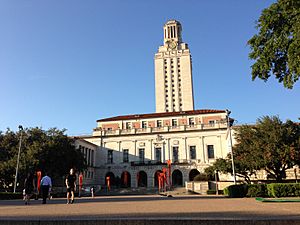
Texas's university system improved greatly because of the oil boom. Before the boom, the University of Texas had only a few small buildings. Oil exploration on university land in West Texas led to the Santa Rita oil well. This gave the University of Texas, and later Texas A&M University, a major source of money. It helped the university become one of the wealthiest in the U.S. Other universities, especially the University of Houston, also benefited from state-owned oil production. They also received donations from rich oil investors. This led to a lot of growth and development on their campuses.
Primary and secondary education also got better. However, the extreme growth in new boomtowns at first caused big problems for schools. They were not ready for so many new students. Even with a lot of money flowing into communities, getting tax money where it was needed was often hard. Communities solved these problems by creating independent school districts. These were education districts separate from city or county government. They had their own power to collect taxes. This type of school district is still used in Texas today. In Texas and nearby states, oil-rich counties participated more in the Rosenwald School program. They spent more public money on matching grants for these schools.
Government and Politics
One important change in Texas government was the creation of a state oil production tax in 1905. The money from this tax helped fund development in the state. It meant Texas didn't need income taxes like other states. In 1919, tax money from oil production was over $1 million. By 1929, it reached $6 million. By 1940, the oil and gas industry paid about half of all taxes in Texas.
Politics in Texas in the early 1900s was shaped by a spirit of Progressivism. Oil money helped expand the highway system and the education system. In general, however, the government had a "laissez-faire" attitude toward business. This means they had few rules. There were few regulations on things like minimum wages or child labor.
The relaxed attitude toward business didn't always apply to large corporations. A lack of money for new businesses was a problem in the early industry. Leaders and citizens worried that money from outside the state would mean losing political power and business chances. This led to lawsuits by the state Attorney General starting in 1906. These lawsuits succeeded. They limited the ability of outside investors, like Standard Oil, to control Texas oil companies.
Mistrust of Standard Oil came partly from suspicion toward "carpetbaggers." This also led to skepticism about labor unions. Union organizers were often seen as trying to help a Northern agenda. This made labor reform slow to develop. Despite anti-union feelings, groups like the International Oil Workers Union gained members and had some influence.
Cultural Changes
As Texas in the 1960s emerged from the prospect of an empire into one of the nation's dozen "imperial states" ... the focus of Northern and national attention was on "change." By "change," most observers meant: When will Texans become more like the rest of the nation?
A lasting idea during and after the oil boom was that Texans didn't want to lose their identity. They wanted to keep their culture even with big changes from the new wealth. Despite its growth, Texas culture in the mid-1900s was still different from other industrial areas.
The chance to get rich from oil created a "wildcatter" culture. This was a bold, risk-taking spirit. Independent business people chased dreams of wealth by buying land and equipment to find oil. Ranchers and farmers, from Texas and other states, started looking for oil. The Oil and Gas Journal once wrote that most of the new oilfields were found by these independent people, not big companies.
Houston led the way in American car culture in the early 1900s. This was thanks to cheap gasoline. By the 1920s, traffic was so bad that Houston was the first city to install connected traffic lights. Visitors were often surprised by how hard it was to walk to stores. Cars were very important in the city. Public transportation had been successful earlier. But later efforts to promote it were mostly defeated in Houston. People preferred public money to be spent on roads instead. Ideas from Houston, like building shopping centers outside the city center and encouraging suburban growth, became big trends across the country.
Another effect of the boom was the growth of unregulated businesses in many communities. This wasn't new in Texas, but the wealth from oil and difficulties in enforcing laws created many new chances for illegal activities. Many communities developed places for gambling. The gaming empire in Galveston lasted into the 1950s. It attracted rich businessmen from Houston. The start of Prohibition and the state's slow enforcement of vice laws encouraged more gambling and bootlegging.
The fast social changes, especially in the 1920s, led to the return of the Ku Klux Klan in Texas cities. They were strongest in Dallas. The new Klan focused on traditional morality, opposing bootlegging and gambling. But prejudice was always part of their agenda.
The oil industry influenced long-term trends in Texas and American culture. The conservative views of early Texas business leaders helped fund the rise of the modern Christian right and the American conservative movement.
Environmental Impact
Even from the start of the oil boom, people tried to protect the environment. But they usually didn't succeed much. It was easy to find oil in the early decades. So, wells were often not fully developed before prospectors looked for new ones. These "wildcatters" wasted valuable oil. They also caused avoidable environmental pollution with many oil strikes. The rush to get oil often led to poor storage facilities. Leaks were common, and water pollution became a serious problem. At the same time, clearing land for oil exploration and the demand for lumber destroyed most of the once-dense forests in Texas. Later efforts helped restore some forests, but they are still much smaller than before.
Industrial activities had few rules. This created a lot of air pollution. It was common to burn off gas pockets in new oil fields, which made the problem worse. As Houston became the most industrialized area, it had the worst air quality. By the 1950s, airline pilots could use lines of haze in the air to navigate to the city. Air quality in cities has improved since then. However, as of 2015, Texas is still the top producer of greenhouse gases in the U.S. Also, as of 2017, NASA ranked Houston as having the worst air quality in the nation.
Another serious effect of oil industries was pollution around the Houston Ship Channel and in Galveston Bay. By the 1970s, these waterways were among the most polluted in the U.S. Factories were major sources of pollution. But city growth around the bay also added a lot. In recent decades, most pollution in the bay comes from storm runoff from smaller businesses, farms, and homes. Conservation efforts by industries and cities have greatly improved water quality in the bay. This has reversed some of the earlier damage to the ecosystem.
After the Gushers
By the 1940s, oil production in the East Texas Oil Field and oil prices became stable. The major cities kept growing, but the extreme growth of the first three decades slowed down. As West Texas and the Panhandle were explored more, the Permian Basin slowly became the top oil-producing area in the state. Independent oil companies were still important for a while. But major new discoveries were increasingly made by established companies. World War II helped Texas become an industrialized and urbanized state, with oil helping this change.
In the 1960s and 1970s, the world's oil supply became tighter. This was due to production peaks in some countries and political problems in others. This led to an energy crisis in the 1970s and early 1980s. Oil prices rose a lot, which greatly benefited Texas. Texas did much better than other parts of the U.S. that faced a recession. A new economic boom happened. While not as big as the early 1900s boom, it pushed Texas's population higher. By the end of the century, Texas was the second most populated state. Some people even use the phrase Texas oil boom to talk about this later period, not just the one after Spindletop.
Important People of the Oil Boom
The "Big Four" Businessmen
Four businessmen were symbols of the 1920s and 30s boom years: H. Roy Cullen, H. L. Hunt, Sid W. Richardson, and Clint Murchison. Cullen was a self-taught cotton and real estate businessman. He moved to Houston in 1918 and soon started looking for oil. Cullen's success led him to start the South Texas Petroleum Company and Quintana Oil Company. Cullen and his wife created the Cullen Foundation. This became one of the largest charity groups in Texas. They gave a lot of money to the University of Houston, the Texas Medical Center, and other causes, especially in Houston.
Hunt first succeeded in the oilfields of Arkansas. But he lost most of his money at the start of the Depression. His fields ran dry, and his land and oil investments drained his resources. He joined Columbus Joiner's project, which opened the East Texas Oil Field. Hunt bought most of Joiner's interests in East Texas. His company, Placid Oil, owned hundreds of wells. He settled in Dallas and was called the richest man in the nation in 1948 by Fortune Magazine.
Richardson was a cattle trader. He started an independent oil production business in Fort Worth in 1919. He soon expanded into many businesses. He owned the Texas City Refining Company, cattle ranches, and radio and TV networks. He was a very private man. Murchison started his career at his father's bank. He soon became an oil lease trader working with Richardson. He expanded into oil exploration in North Texas, then around San Antonio, and finally the Dallas area. He went on to create the Southern Union Gas Company. He also became a developer in the East Texas field. He expanded his business to international oil and gas operations in Canada and Australia. His son Clint Jr. later formed the Dallas Cowboys football team. Murchison and Richardson were known as major political figures. They had close ties to President Dwight D. Eisenhower and Vice President Richard M. Nixon, as well as FBI chief J. Edgar Hoover and President Lyndon B. Johnson.
Other Notable Figures
Other rich Texans in the oil industry became well known. Often, it was for their unique personalities as much as their wealth. Howard Hughes, son of Howard R. Hughes Sr. (who invented a key drill-bit technology), became famous for his success in aviation and film. He also became known for his unusual habits and later health issues.
Glenn McCarthy started as a modest oil worker. He found wells around the Houston area. In 1932, he struck oil at Anahuac near the Galveston Bay. Over the next ten years, he made many other discoveries. He quickly became one of Texas's richest men. His spending was legendary. His love of bourbon led him to create the WildCatter bourbon brand. His extravagant lifestyle made him a national celebrity in the 1940s and 1950s. The media loved stories of Texas oil wealth.
Jim West Jr. inherited his fortune from Jim West Sr. West Sr. was an early Houston businessman who helped shape the city and state. Jim West Jr. was known as "Silver Dollar Jim." He always carried silver dollars and gave them to doormen and others. Many people saw him as the most flamboyant Houston oilman. His lavish spending and his hobby of helping law enforcement were well known. He used his many cars, which were filled with weapons, sirens, and radios, to chase criminals with the Houston police.
Oil in Popular Culture
At first, most Americans knew about oil production in Texas. But the extreme wealth it created for the first thirty years after Spindletop was largely unknown. Of the four most important oil businessmen at the end of World War II, only a few articles about them appeared in New York Times. Stereotypes about Texas usually focused on cowboys and cattle.
By the late 1940s, national magazines like Life and Fortune started reporting on the extreme wealth of some Texans. A stereotype emerged of the "newly rich" Texas oil millionaire. The media often showed them as tough, wild, and spending a lot of money. In 1956, the movie Giant helped create this image of Texans as funny, unique characters. Glenn McCarthy was the inspiration for the character Jett Rink in the film. Other films like Boom Town and War of the Wildcats, and books like The Lusty Texans of Dallas also shaped how people saw oil's influence in Texas.




